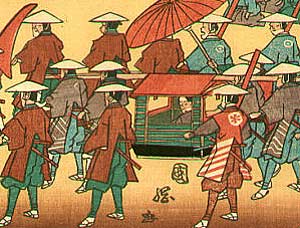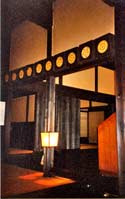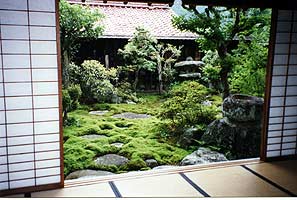In the Footsteps of the Samurai: Walking the Nakasendo
Part 2
By Deborah Klens-Bigman, Ph.D.
Editor’s Note: This
is the second part of a first hand account of the author’s expedition
along the famous foot path that in Samurai Japan connected the two great
centers of Japanese power, culture, and civilization. Part
1
 |
An important government dignitary with escorts
and retainers traveling along the Nakasendo road between Edo and
Kyoto (Japan) sometime in the 1860's.
|
Tsumago-juku turned out to be a study in contrasts. The tiny town was
nestled in a crevice in the mountains (I would have hesitated to call
it a valley of any kind) cut by a rocky, fast-moving stream. At one end
of the town, an anachronistic- looking Showa Period hydroelectric plant
towered over the trees. Somehow, the stream did not look as though it
could possibly make the plant worthwhile. The Nakasendo ran along the
stream and through a series of back yards, where people had simply turned
it into part of the landscape, banked in flowers.
|
Old, unadorned buildings on the main street of
Tsumago-juku.
|
When I got into the town proper, I came to understand at last what "museum
town" meant: By agreement of the residents in 1971, all of the old
buildings had been restored or preserved just as they were in the late
Edo Period. Though the trappings of modern life were certainly everywhere
in evidence, the streets were narrow, and the building facades were unadorned
with paint or finish. Unlike Magome-juku's touristy charm, Tsumago-juku
looked very much like you could cover over the paved road with dirt and
step back in time. No wonder there was no love lost between them. Instead
of sunny glass-front shops, merchants kept their souvenirs inside narrow
entryways and old-fashioned workshops.
Another confused traveler phone call from the bus stop, another ride
to another minshukan, this time a beautiful, modern establishment. The
proprietors were surprised when I told them I had traveled alone, on foot,
from Magome-juku. I certainly looked as though I had done something of
the kind - sweaty, and looking as though my feet were killing me. I had
no idea there was so much to do in Tsumago-juku, however, so I put down
my things, changed my shoes, and trotted out to explore.
|
A building interior in Tsumago-juku.
|
Tourists were in evidence here as well, making merry at a local soba-ya
(a type of eating establishment) where I had lunch. I was tempted just
to sit and drink beer all afternoon with them (though I would not have
lasted very long), but here was the Edo Period sense I had been looking
for. It was already mid-afternoon, and I had to go see everything while
I could.
In addition to the rambling, narrow streets, where the main road paralleled
or intersected and joined with the Nakasendo, the town had restored two
official guest houses, the Honjin and the Waki-Honjin (nicknamed the Okaya).
These were established as accommodations for daimyo and imperial officials
who passed through on official government business, along with their many
retainers and servants. The buildings were now private museums. Since
they were not "National Treasures," I was free to photograph
as much as I liked, inside and out. Interestingly, and in accordance with
the town's declaration that buildings within it were not to be altered
or sold, the descendants of the samurai clans who originally managed the
guest houses were running them still.
I explored the Honjin first. Though quite grand, it was one of a series
of guesthouses that were set up along all five of the original highway
routes. Tsumago-juku, however, is famous for logging, and obviously, woodworking.
The interior, made of satiny Japanese Hinoki, was gorgeously finished
and has been restored according to a floor plan discovered in 1995 that
dated to the late Edo Period (1830's).
 |
A room in the Honjin. (Left) |
| The garden outside the entryway
to the Honjin. (Below) |
 |
A beautiful, formal garden and covered entryway fronted a large reception
room with an adjoining kitchen on the first floor. According to the literature,
daimyo and kuge (imperial officials) would bring their own kitchen staff
to prepare food rather than have someone else do it, both as a matter
of taste and a security precaution.
|
|
|
A cooking pot in the kitchen of the Honjin.
|
A scroll depicting the Emperor and Empress Meiji,
commemorating their visit to the Honjin.
|
A well in the courtyard of the Okaya.
|
Other items besides the traditional furnishings included some mementos
of the Emperor Meiji, who took a short rest break at the Honjin when he
came through on a tour of the area in 1880.
The guide, a local college student, when I explained that I would be
writing about the place, walked me throughout the splendid building and
was happy to explain as much about the place as my hanbun Japanese could
absorb.
The Waki-honjin, (i.e. "side" honjin) or Okaya, was just up
the street. This smaller, less officious-looking building housed attendants
of the traveling daimyo or kuge. Occasionally, if the Honjin was already
occupied, the higher-ups would have to make do and stay there as well.
One thing that struck me most about both buildings was that the interiors,
in the waning afternoon light, were very dark. The restorers wisely only
provided minimal artificial lighting, perhaps to shield the fixtures from
too much direct light, but in the process they provided a real sense of
what it must have been like to be there as a traveler years ago.
The Okaya abutted a small museum. Inside, the exhibits traced the town's
history. Surprisingly (for Japanese museums vary widely), the descriptions
were bilingual in Japanese and English, and were fairly scholarly. The
area's principal resource, of course was, and remains, lumber. Trees from
Tsumago-juku were highly prized, and their harvest was strictly controlled,
first by the Edo period government, then by successive imperial ones.
(The inspection building I passed on the way to Tsumago-juku was simply
one of many checkpoints). The saying "one tree, one head" meant
that anyone cutting a tree without proper permission would lose his life.
This situation continued until the Showa Period, when the citizens were
at last allowed to directly profit from their labors. I was impressed
by the sense of defiance in the museum exhibits, which were critical of
government timber policies right up to recent times.
|
Old woodworking tools in the museum at Tsumago-juku.
|
As if to illustrate the relatively recent sense of individual enterprise,
all around the town little wood shops sold all sorts of wares - everything
from furniture to bento boxes and carvings of a rich, reddish-brown hue.
I bought a small bento box for my little collection.
As it was getting late, I turned back to the minshukan, this time by
the more gently-sloping highway. From there, I could look down on the
Nakasendo by the stream, as the path wound through various backyards.
Small knots of schoolkids were trekking home, chattering together. Did
they know, I wondered, that they walked the paths of their ancestors –
the merchants, servants, workers and samurai of Edo Period Japan? Unlike
Magome-juku, where history had become a theme park, in Tsumago-juku people
lived quite easily alongside the past.
|
Old, unadorned buildings on the main street of
Tsumago-juku.
|
At the minshukan, I enjoyed a dinner of fresh fish and an assortment
of mountain vegetables. Outside the dining room window, I could hear the
little rushing stream. Afterwards, exhausted by the day, I fell dead asleep
on my futon. Hours later, I was startled awake by a massive thunderstorm.
Rain came down in torrents, buckets, whatever you'd like to call it.
The next morning it was still pouring, and the quaint little stream had
become a raging cataract, no doubt producing more than enough energy to
justify the existence of the little hydroelectric plant after all. If
I had arranged to hike on to Nagiso-juku, I would have had to be uncharacteristically
stubborn to go on such a day.
Instead, after a fabulous breakfast, a taxi took me to the train station
at Nagiso-juku. Half-reluctantly, I began my slow journey back to modern
Japan, by way of the temples of Koyasan.
All Photos by Deborah Klens-Bigman, Ph.D.
Work Cited
Basho (Yuasa, Noboyuki, tr.)
1966The Narrow Road to the Deep North and Other Travel
Sketches Middlesex: Penguin Books, Ltd. 1967
References
DuBois, Alice
2005“In Japan, Hiking an Ancient Trail to See
Rural Life” NY Times (March 20) http://travel2.nytimes.com/2005/03/20/travel/20japanhike.html
2006
Nagiso-Machi Authorities, Tourism Section n.d. “Tsumagojuku-Honjin,
Wakihonjin-Okuya, Rekishi Shiryokan” (brochure) n.d. “A
Short Guide to Tsumago” (brochure)
Tsumago-juku Honjin Museum n.d. “Tsumago-Juku
Honjin” (handout). n.d. “Okuya, the ‘Waki-honjin’
of the post town Tsumago on the old Nakasendo” (handout).
www.japan-guide.com
200 5“Travel - Kiso Valley – Magome”
2006
2005 “Travel - Kiso Valley – Tsumago”
2006
About The Author:
Deborah Klens-Bigman is Manager and Associate Instructor of iaido at
New York Budokai in New York City. She has also studied, to varying extents,
kendo, jodo (short staff), kyudo (archery) and naginata (halberd). She
received her Ph.D in 1995 from New York University's Department of Performance
Studies where she wrote her dissertation on Japanese classical dance (Nihon
Buyo). and she continues to study Nihon Buyo with Fujima Nishiki at the
Ichifuji-kai Dance Association. Her article on the application of performance
theory to Japanese martial arts appeared in the Journal of Asian Martial
Arts in the summer of 1999. She is married to artist Vernon Bigman. For
FightingArts.com she is Associate Editor for Japanese Culture/Sword Arts.
|